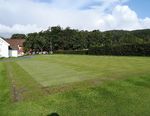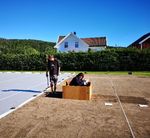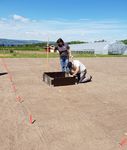Testing of new turfgrass species and varieties in - SCANGREEN 2019-2022 By Pia Heltoft, Karin Juul Hesselsøe, Trygve S. Aamlid, Karin Normann ...
←
→
Page content transcription
If your browser does not render page correctly, please read the page content below
Testing of new turfgrass
species and varieties in
SCANGREEN 2019-2022
By Pia Heltoft, Karin Juul Hesselsøe,Trygve S. Aamlid,
Karin Normann, Bjarni Hannesson and Kemeng Xiao
Popular Scientific Articles - STERF, April 2020Testing of new turfgrass species and
varieties in SCANGREEN 2019-2022
Figure 1. Sowing at Apelsvoll (17-18. June) and dronephoto one month after estasblishment
(photos: Pia Heltoft and Maximillian Pircher)
SCANGREEN is a Scandinavian sites in the Nordic region. The trials Next, the field trial at Landvik was
variety testing program for gras- are located at Landvik in Norway and established. It was sown on 1-2. July.
ses and varieties for golf greens cut Sydsjællands Golf Club in Denmark Figure 2 shows the establishment. The
at 3-5 mm. The program started (southern test zone), as well as at trial was immediately after seeding
in 2003. The trials that have been Apelsvoll in Norway and Reykjavik in covered to retain moisture and heat.
sown this year are thus the fifth test Iceland (northern test zone). As part of
round. The program takes place an American-Nordic collaboration, the The experiment in Iceland was esta-
over a period of 4 years (2019-22), new test round has also been extended blished on 6-10. July. The experiment
one establishment year and three to include trials at the University of was sown in stages due to unstable
evaluation years. Massachusetts and the University of weather with lots of wind as well
Minnesota in the United States. as rain and thunderstorms. Figure 3
Testing of new varieties is important New trials were established in the shows the experiment during esta-
for improving the quality of turfgrass. summer of 2019. blishment and after one month.
In breeding, the focus is particularly
on disease resistance and tolerance to The trial at Apelsvoll was sown on The last established field was the trial
abiotic stress (frost, ice, water, etc.). 17-18. June as the first of the Nordic at Sydsjællands Golf Club, which was
In SCANGREEN, the varieties are trials. Figure 1 shows the test field sown on 15-19. August (Figure 4).
tested at four different experimental during establishment and drone photo
after one month.
2Figure 2. Sowing at Landvik (1.-2. July) and the established green 6 weeks later. (photos: Karin Juul Hesselsøe).
Figure 3. Sowing on Iceland (6-10. July) and one month after sowing (foto: Bjarni Hannesson)
Figure 4. Sowing at Sydsjællands Golf-
klub, Denmark (15-19. August)
(photo: Karin Normann)
3Figur 5. Participants at the workshop • Creeping bent (Agrostis stoloni-
at Landvik 4. September 2019: First fera)
row from the left: Pia Heltoft (Apelsvoll
og projectleader SCANGREEN) and Ka-
• Common bent (Agrostis capil-
rin Juul Hesselsøe (Landvik). Second laris)
row from the left: Tatsiana Espevig • Velvet bent (Agrostis canina)
(Landvik), Karin Normann (Sydsjæl- • Smooth meadow-grass (Poa pra-
land) and Kristine Sundsdal (Landvik). tensis)
Third row from the left: Kemeng Xiao • Rough meadow-grass (Poa trivia-
(student from China), Tanía Gneist
(Sydsjælland) and Bjarni Hanneson lis)
(Reykjavik). Fourth row from the left: • Perennial ryegrass (Lolium pe-
Lars Havstad (Landvik, projectleader renne)
SCANTURF), Corinne Berthuit (France,
representative for the European variety Species and varieties showed good
testing), Trond Pettersen (Landvik)
and Trygve S. Aamlid (Landvik) Fifth results in the previous SCANGREEN
row from the left: Markku Niskanen round, especially in the southern test
(Ylistaro, Finland (SCANTURF) and zone. Therefore, in this testround, the
Jan Tangsveen (Apelsvoll)). Sixth row: following seed mixtures will be stu-
Anders Søndergaard Larsen (Tystofte died at Landvik and Sydsjælland:
Denmark (SCANTURF))
1. 85% Festuca rubra + 15% Agros-
tis stolonifera
Workshop at Landvik Seedmixtures are 2. 85% Festuca rubra + 15% Agros-
tis capillaris
On September 4th, all participants
included again 3. 85% Festuca rubra + 7.5% Ag-
rostis stolonifera + 7.5% Agrostis
in SCANGREEN and SCANTURF SCANGREEN is funded 90% by capillaris
gathered for a workshop at Landvik. STERF and 10% by registration fees. 4. Pure red fescue (variety mix with
The purpose of the workshop was to During this trial period, 30 new varie- three varieties)
review the protocol for the experi- ties have been registered, divided on 5. 20% A.stolonifera + 80% Lolium
ments and coordinate the evaluation 8 different species. The varieties are perenne
of the experiments in order to get as compared with reference varieties of
uniform an assessment of the different the same species. Varieties of the fol- The varieties are evaluated monthly.
grades as possible. Figure 5 shows lowing species are being tested: They are ranked by overall quality,
a picture of the participants in the • Slender creeping red fescue (Fe- winter hardiness, disease resistance
workshop. stuca rubra ssp. litoralis) and competitiveness to weeds and
• Chewing fescue (Festuca rubra moss.
ssp. commutata)
Results
Results from SCANGREEN will
in the coming years be presented at
field walks at the various test sites
and published on www.sterf.org and
in the Nordic greenkeepers magazi-
nes. Preliminary results are shown in
Figure 6. These are results from the
establishment of different species in
the Landvik trial. Here, the coverage
rate (%) was determined weekly by
Kemeng Xiao, a Chinese student who
participated in the experimental work
this summer.
The figure shows that perennial ry-
egrass, common bent and velvet bent
established themselves the fastest. For
creeping bent, the coverage percen-
tage improved significantly from three
Figure 6. Coverage (%) after sowing of different grasses in the SCANGREEN trial at to four weeks after sowing.
Landvik in the summer of 2019. (Average for all varieties within a species).You can also read


























































